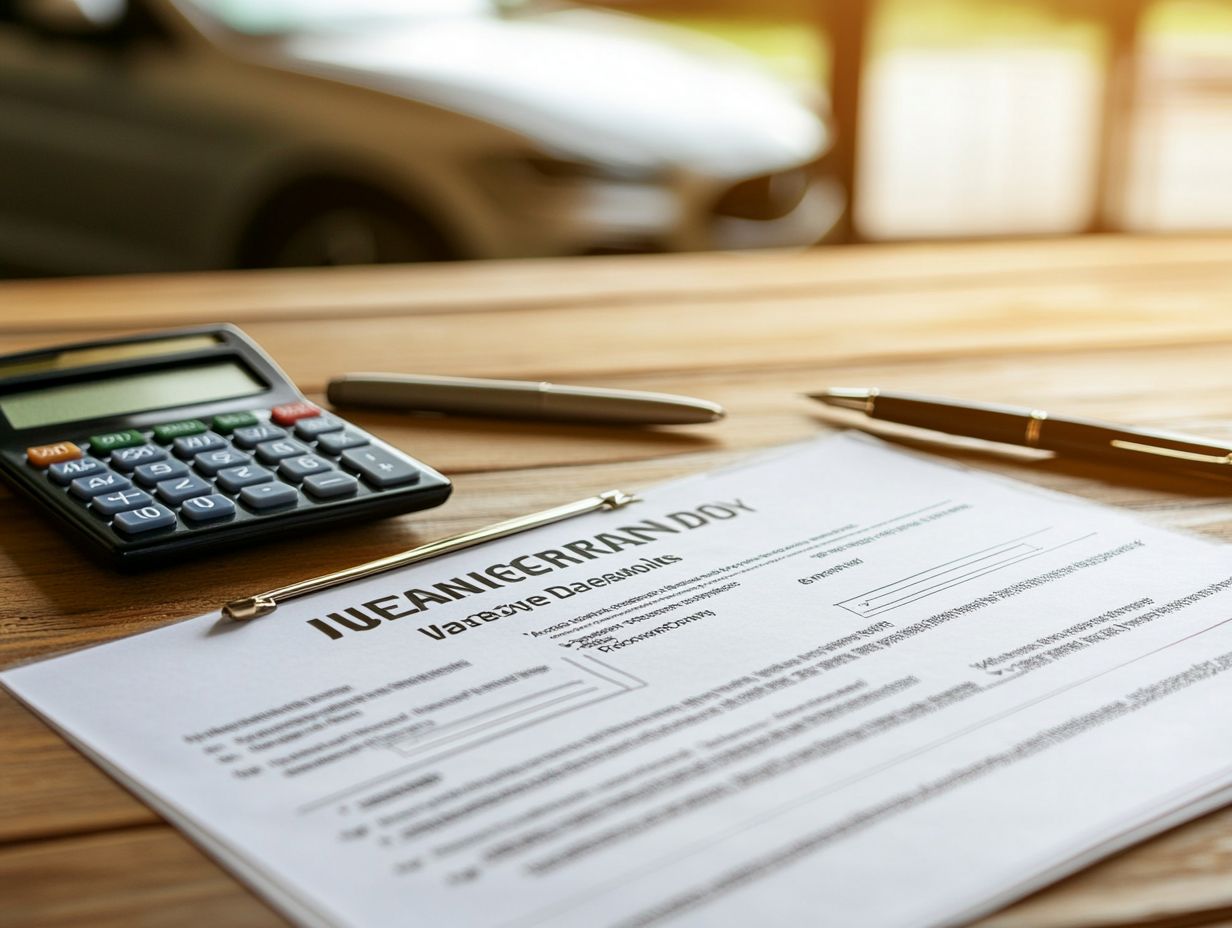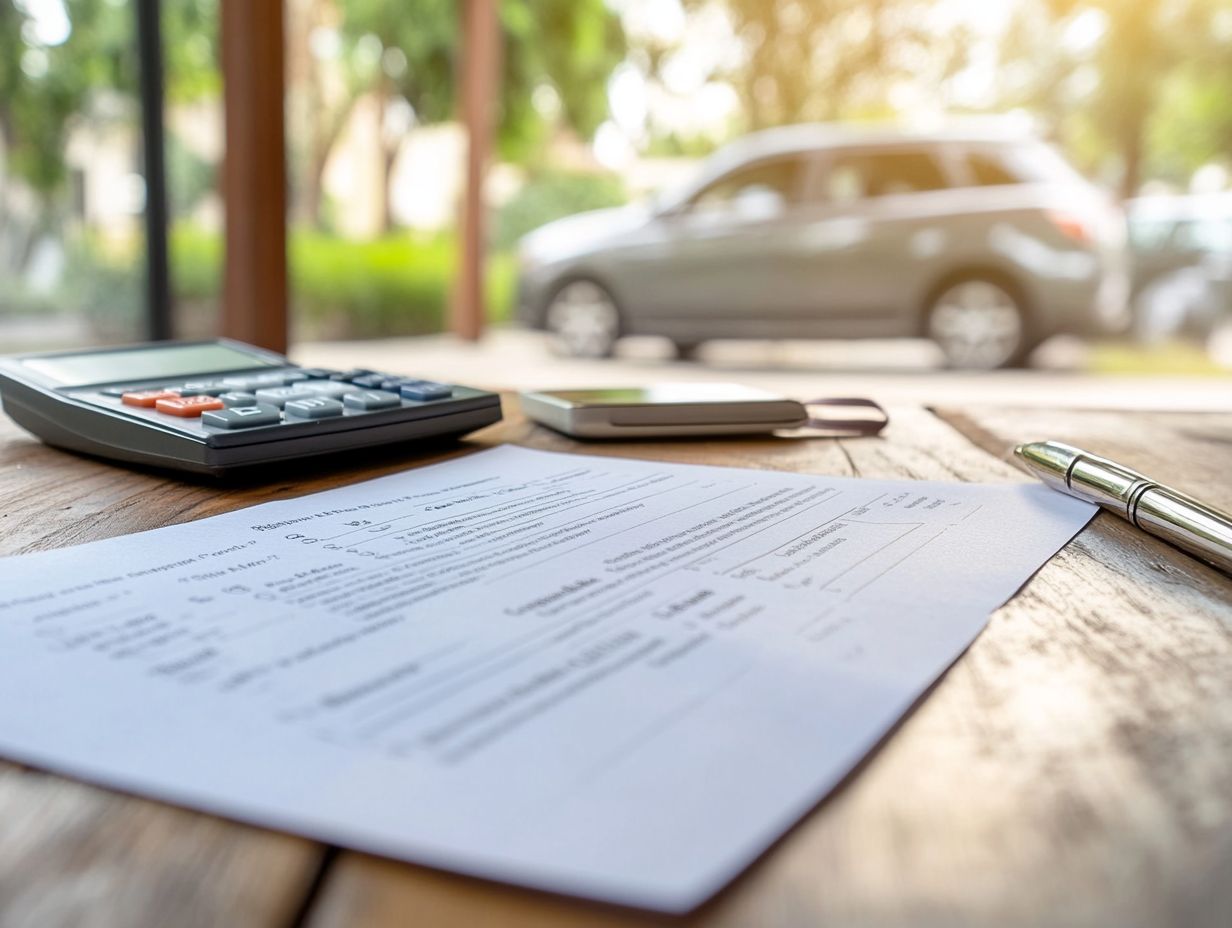What is Liability Coverage in Auto Insurance?
Navigating the world of auto insurance can feel like an intricate maze, especially when it comes to understanding liability coverage. Liability coverage is your financial safety net in case of an accident, protecting you from costly damages.
In this article, you’ll find a detailed breakdown of the different types of liability coverage, including bodily injury and property damage. It also examines minimum state requirements and how these elements impact your insurance premiums. Get ready to empower yourself with essential insights to make smart choices about your auto insurance!
Contents
- Key Takeaways:
- Understanding Auto Insurance Coverage
- What is Liability Coverage?
- Types of Liability Coverage
- Minimum Requirements for Liability Coverage
- Additional Coverage Options
- Table of Contents
- How Liability Coverage Affects Your Premium
- Frequently Asked Questions
- What is Liability Coverage in Auto Insurance?
- Do I need Liability Coverage in Auto Insurance?
- What does Liability Coverage in Auto Insurance cover?
- What are the limits of Liability Coverage in Auto Insurance?
- Can I increase my Liability Coverage limits?
- Does Liability Coverage in Auto Insurance cover me if I am at fault for an accident?
Key Takeaways:

- Liability coverage protects you from financial responsibility in the event of an accident.
- It includes bodily injury liability, which covers medical expenses and lost wages for others involved in the accident, and property damage liability, which covers damage to others’ property.
- The amount of liability coverage required varies by state. Consider additional options like umbrella policies, which offer extra coverage beyond your regular auto insurance, and personal injury protection for full protection of your assets.
Understanding Auto Insurance Coverage
Understanding auto insurance coverage is essential for vehicle owners, as it offers protections against unexpected events. Auto insurance policies typically include options like liability insurance, collision coverage, and comprehensive coverage, each specifically created to fulfill distinct needs.
From bodily injury to property damage, grasping the nuances of these policies is vital to ensure you have the right protection and comply with state regulations.
Overview of Different Types of Coverage
Auto insurance offers a variety of coverage options, each designed to cater to your specific needs and protect against risks that come with vehicle ownership. At the core of this coverage is liability insurance, which serves as your financial safety net if you are deemed responsible for damage or injury to another party.
Collision coverage ensures that your vehicle is repaired after an accident, allowing you to get back on the road quickly. Comprehensive coverage takes your protection further, covering unexpected incidents like theft, vandalism, or even natural disasters, making it essential to secure your investment.
By understanding how these different types of coverage work together, you can make informed choices tailored to your unique circumstances, ensuring you re well-prepared for whatever comes your way.
What is Liability Coverage?
Liability coverage is a cornerstone of your auto insurance, protecting you from financial setbacks arising from claims related to bodily injury and property damage inflicted on others in an accident. Additionally, understanding personal property coverage in auto insurance can further safeguard your finances and cover legal fees if you face a claim.
Definition and Purpose
Liability insurance helps pay for injuries and property damage you might accidentally cause to others while driving. This type of insurance is vital for protecting your financial well-being, as it assists in covering medical expenses for injured third parties and repair costs for damaged property.
Often required by law, liability insurance ensures you can meet your legal obligations should an accident occur, preventing overwhelming financial burdens. This coverage also fosters societal responsibility by ensuring victims receive fair compensation, which builds trust within the community.
Understanding the intricacies of liability insurance is crucial for anyone looking to navigate the potential risks that come with vehicle ownership and operation.
Take a moment to review your liability coverage or consult an insurance expert today to ensure you re fully protected!
Types of Liability Coverage

You ll find that liability coverage comes in various forms, each tailored to different aspects of financial protection in case of an accident. The primary categories include bodily injury liability, which addresses injuries sustained by others, and property damage liability, which covers damage to someone else’s property.
Bodily Injury Liability
Bodily injury liability coverage is designed to cover the medical bills and related expenses of others injured in an accident for which you are responsible.
This coverage is essential because it alleviates the financial strain of hospital stays, rehabilitation, and potential long-term care. It also acts as a crucial safety net against the risk of legal action that may arise from the incident. If another party sustains injuries in an accident, they may pursue compensation for pain and suffering, lost wages, and ongoing medical treatment.
By securing robust bodily injury liability coverage, you protect yourself from the steep costs associated with lawsuits, ensuring your financial stability while providing critical support to those affected.
Property Damage Liability
Property damage liability coverage takes care of the expenses tied to damage inflicted on someone else s property when you’re at fault in an accident.
This insurance is a must-have for your financial safety. Many people underestimate the impact of a single accident. The costs for repairs or replacements can quickly exceed what you might have set aside in savings.
By securing adequate coverage limits, you ensure that you can effectively handle any damage claims brought against you. This not only safeguards your financial health but also provides you with invaluable peace of mind. In the world of insurance policies, property damage liability is a vital element that promotes responsible ownership and encourages safe driving practices.
Minimum Requirements for Liability Coverage
Minimum requirements for liability coverage can differ from one state to another. However, they typically stipulate that drivers maintain a baseline level of insurance. This is vital to safeguard against financial liabilities in case of an accident.
State Laws and Limits
State laws dictate the minimum coverage limits required for liability insurance, and these limits can vary significantly from one jurisdiction to another.
Understanding these differences is crucial for you as a driver. Each state has its own requirements regarding coverage amounts, which can directly impact your financial protection in the event of an accident. Typically, these coverage limits are influenced by the state s legal framework, average costs for vehicle repairs and medical expenses, and local economic conditions.
This variation can have substantial implications for you, including potential legal penalties for non-compliance and increased premiums based on risk levels. Therefore, it s essential for you to familiarize yourself with your specific state requirements and ensure you have adequate coverage to protect against unforeseen liabilities.
Additional Coverage Options

Along with your standard liability coverage, you have the opportunity to explore a variety of additional coverage options. Consider enhancing your financial security with umbrella policies, which provide extra coverage beyond standard policies, and personal injury protection, giving you an additional layer of peace of mind on the road.
Don’t wait until it’s too late! Ensure you have the right coverage options today to safeguard your future.
Table of Contents
- Umbrella Policies and Personal Injury Protection
- How Liability Coverage Affects Your Premium
- Factors That Impact Cost
- Frequently Asked Questions
Umbrella Policies and Personal Injury Protection
Umbrella policies provide you with an additional layer of liability insurance that extends beyond conventional coverage limits. Personal injury protection covers medical expenses for you and your passengers, regardless of who is at fault.
These two types of insurance work together to give you unbeatable protection against unexpected accidents and liabilities. While standard liability insurance addresses basic risks associated with car accidents, an umbrella policy enhances your safety by offering higher limits, protecting your assets from claims that could exceed standard coverage.
Personal injury protection ensures that medical expenses from injuries are covered right away, lifting the financial burden in the aftermath of an accident. Together, these policies boost your security, allowing you to navigate life’s uncertainties with greater peace of mind.
How Liability Coverage Affects Your Premium
The type and level of liability coverage you select play a crucial role in determining your auto insurance premium and overall insurance policy costs.
Factors That Impact Cost
Several factors are vital in determining the cost of your insurance policy. These factors include the level of liability coverage you choose, your driving history, and the coverage limits you establish.
Your choices regarding liability coverage can significantly impact your overall premium. For example, selecting higher limits usually results in a higher premium, but it provides better financial safety in the event of an accident. The type of liability coverage whether it s bodily injury, property damage, or personal injury protection also affects costs. Different insurance providers assess these elements differently, considering the risk associated with each policy.
External factors like your location, the type of vehicle you drive, and even your credit score also contribute to the final premium. This creates a complex landscape of considerations that shapes the best coverage tailored to your needs.
Frequently Asked Questions
What is Liability Coverage in Auto Insurance?

Liability coverage in auto insurance helps protect you financially if you are found at fault for an accident. It covers costs for damages or injuries to other people or their property.
Do I need Liability Coverage in Auto Insurance?
Yes, in most states, liability coverage is required by law for all drivers. It is designed to protect you from potential financial burdens if you are at fault for an accident.
What does Liability Coverage in Auto Insurance cover?
Liability coverage typically includes both bodily injury liability and property damage liability. Bodily injury liability covers costs related to injuries or death of other people involved in an accident, while property damage liability covers damage to their property.
What are the limits of Liability Coverage in Auto Insurance?
The limits of liability coverage refer to the maximum amount your insurance company will pay for damages or injuries in an accident. These limits are usually expressed as two numbers, such as 100/300, with the first number representing bodily injury coverage and the second representing property damage coverage.
Can I increase my Liability Coverage limits?
Yes, you can increase your liability coverage limits if you choose. It is recommended to have enough coverage to protect your assets in case of a lawsuit resulting from an accident.
Does Liability Coverage in Auto Insurance cover me if I am at fault for an accident?
Yes, if you are found at fault for an accident, your liability coverage will help cover costs for damages or injuries to other people or their property. However, it does not cover your own vehicle or injuries.
For personalized advice or to get a quote, consult with an insurance expert today!






